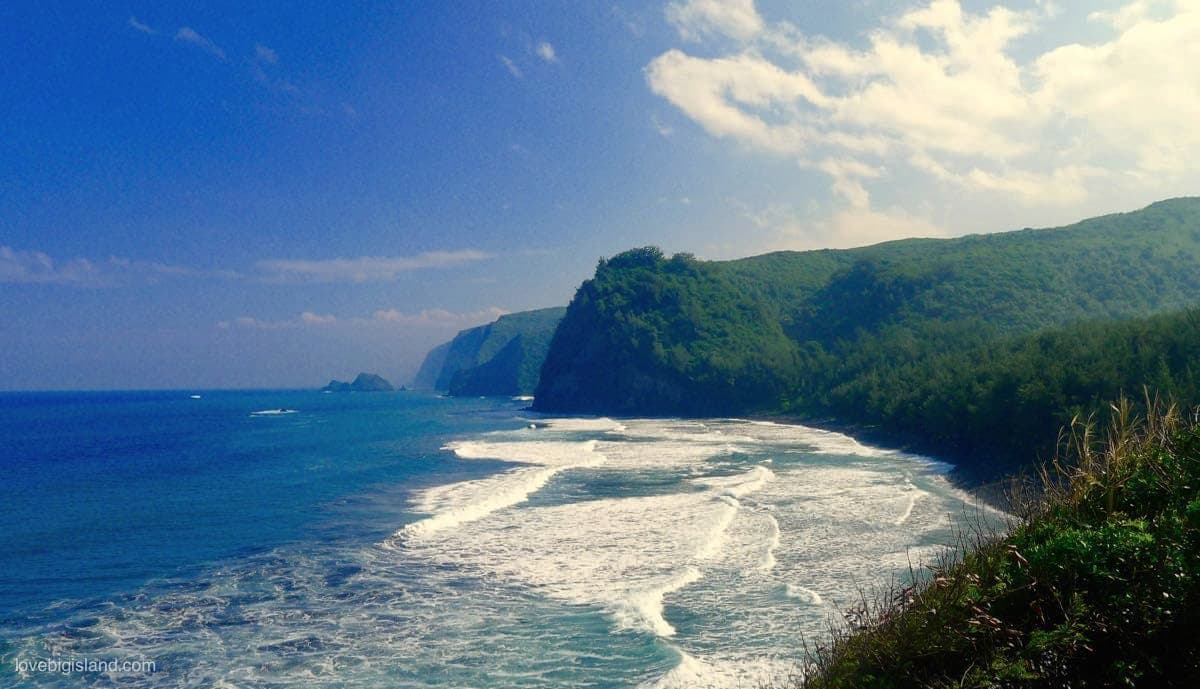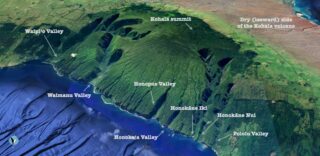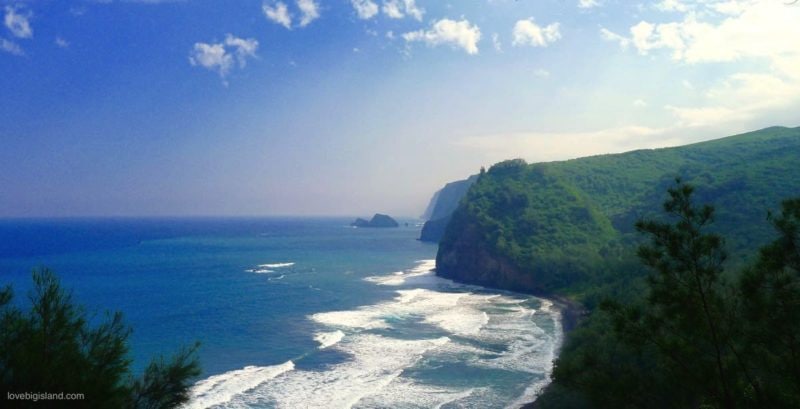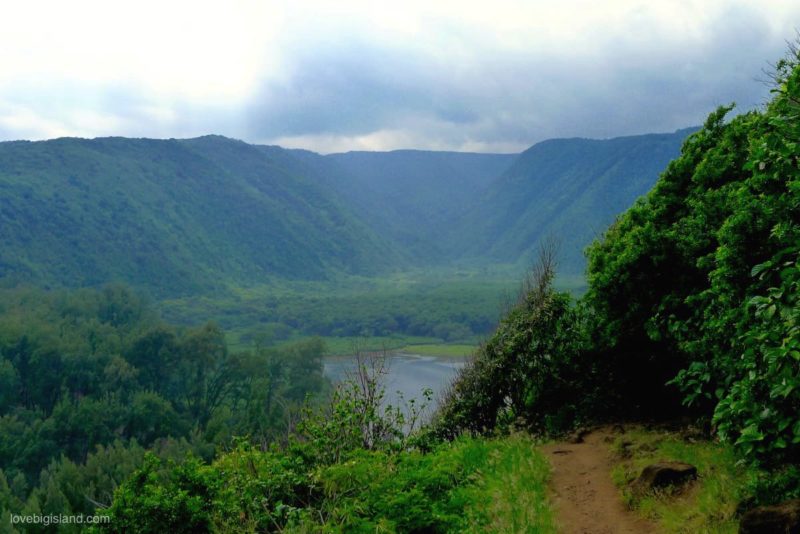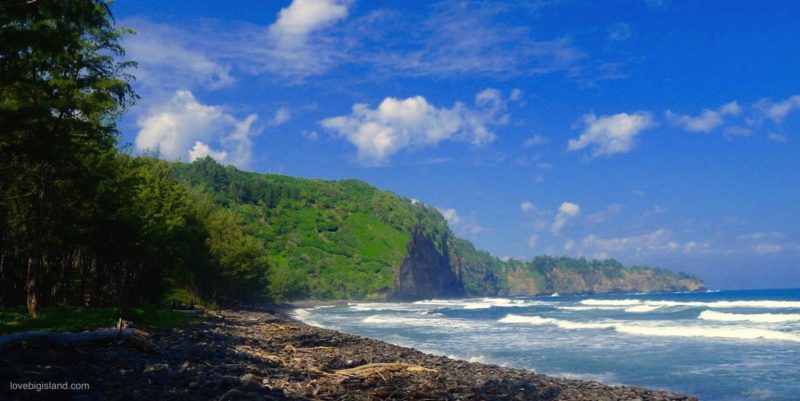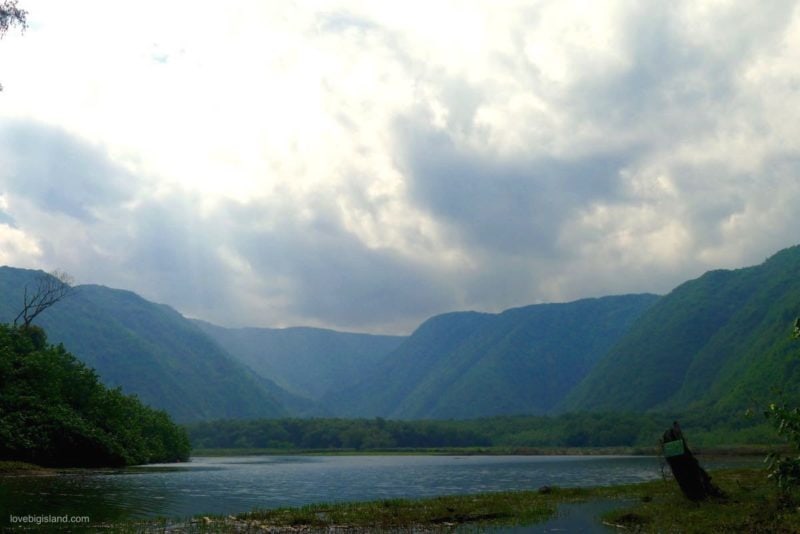Pololū valley is the most northern of the impressive valleys that are carved into the Kohala volcano at the lush green pastures of the Kohala region on the Big Island.
The spectacular views of the valley and the steep cliffs that end in the ocean are worth a trip on their own, but the real thing to do here is hiking to the black sand beach at the valley floor! There also are some pretty cool things to do close to Pololu valley to make your visit into a small road trip.
Table of contents
- Introduction to Pololū Valley (history)
- Visiting Pololu Valley
- Things to do close to Pololu Valley
Table of Contents
- Introduction to Pololū Valley (history)
- Visiting Pololu Valley
- Things to do close to Pololu Valley
Pololu Valley history
The Kohala Volcano last erupted about 120.000 years ago (!) and is the oldest of 5 volcanoes that make up the Big Island. Between 250.000 and 300.000 years ago the Kohala volcano experienced a truly massive landslide in which a part of the volcano fell into the ocean.
This landslide is responsible for the now famous sea cliffs on the windward Kohala shoreline but also triggered a giant tsunami that left marine deposits multiple 100 ft high on the other islands (read more). Remnants from this landslide can still be found under water 81 miles (130 km) from the current coastline. (read more about the geological history of Kohala).

The cliffs of the Kohala coastline were formed during a catastrophic landslide between 250.000 and 300.000 years ago during which a large part of the volcano slipped into the ocean. Pololū Valley is the first valley from the right. Image adapted from source (by Eric Tessmer).
The 7 valleys of the Kohala volcano
During its long lifetime, erosion by rainwater has cut multiple deep gulches, gorges and valley in the flanks of the windward side of the Kohala volcano. You can see this now as a series of 7 valleys (a valley has a flood plane at the valley floor) of which Pololū Valley is the most northern one.
From Pololu valley on these valleys stretch towards the south-east in an impressive display that you can partly see from the Pololu lookout point. This series consists of the following valleys:
- Pololū Valley
- Honokāne Nui
- Honokāne Iki
- Honokeʻa
- Honopue
- Waimanu Valley (campsite, more information)
- Waipiʻo Valley (the most visited of the valleys)
The water that carved out these valleys is also the reason why these valleys were a popular place to live for the native Hawaiians: a constant supply of water is essential to grow culturally significant crops such as Taro. The steady supply disappeared in 1905 when the Kohala Ditch network was completed. This 22 mile network of flumes and ditches is essential for the water supply of a part of the island but also made sure that there are no permanent residents anymore in Pololu Valley.
The Pololu Trail Steward Program
The Pololu Trail Steward program is a recent initiative in which one or more local stewards are present at the Pololu Valley trailhead to inform and educate visitors as they arrive, as well as monitor the trail and beach. They get to share Pololū’s great historical and cultural values, along with the and significance the area has for those living in and visiting Kohala.
Please have a chat with them when you arrive to learn more about the area and treat them kindly. Mahalo!
Visiting Pololu Valley
There are several “levels” of visiting Pololu valley. The simplest is driving to the lookout for the views, but you can also make a small (but steep) hike to the valley floor to check out the beach. If you like exercise you also opt for a hike to the next valley.
All options are described below:
- The Pololu Valley Lookout (+ directions)
- The hike into Pololu Valley
- The black sand beach
- Continue hiking to the next valley: the Honokane Nui trail
- How to get to Pololu Valley
Good to know: there are no public restrooms at the lookout or down in the valley. The closest restrooms are at the Keokea Beach Park (10 minutes from the overlook) and just behind the King Kameha Statue which you will pass in Kapaʻau en-route to the overlook from Hawi.
The following 2.5 minute video shows aerial footage of the cliffs, the beach and the upper valley:
Pololū Valley Lookout
The Pololu lookout gives you a magnificent view over Pololu Valley and the impressive sea cliffs that slowly crumble into the ocean. If you are visiting in the winter months (from ~December to ~March) this is a great place to try and see humpback whales.
You can stick around for 10 minutes to snap a few pictures of the breathtaking coastline and take in the scenery but the real attraction at Pololu is the short but steep hike down into the valley and the black sand beach at the valley floor. The vertical distance from the overlook point down to the valley floor is 490ft (150m)
The hike down into Pololu valley
The trail down into the valley is a section of the old government road to ʻĀwini. For this reason it is both referred to at the Pololū Trail and the ʻĀwini trail. The trail itself offers breathtaking views of the cliffs, the valley and the black sand beach on the valley floor.
The hike down the side of the cliff to the valley floor is short but steep: ~420 ft in 0.6 miles (126 meters in 1.0 kilometers) and takes about 20 to 25 minutes for the average hiker. From the valley floor it is a short and easy stretch to the beach. During or after rains the trail can be slippery and because of the relatively steep average grade of the trail (13%) we rate the difficulty as moderate. Don’t worry, there is plenty of time on the beach to take a breather!
As we do for most places on the Big Island we recommend to visit Pololu Valley early in the day. Not only will you beat most of the crowds but you will also benefit from more pleasant temperatures. It can get especially hot and sweaty during the hike up!
Bring enough water with you and keep in mind that there are no restroom facilities in the valley or at the lookout.
The Black Sand Beach of Pololu Valley
The black sand beach at the valley floor looks like a beach at the end of the world. A lush tropical forest surrounded by almost 500 ft high cliffs and fronted by an ocean that more often than not has high surf and rough waves.
The beach itself is made out of a mix of black sand and large boulders. These stones can make it uncomfortable to walk into the water so if you do want to take a swim try to bring shoes that can get wet.
The ocean at Pololu valley is not a safe place to go swimming. High surf, undertow, and rip tides are frequently present so only go in the water if you are a good swimmer and don’t get in too deep.
Behind the beach you can find large dunes and ironwood trees that protect the valley from floodwaters. There are some trails parallel to the beach that make it easy to get to the other side of the valley that are worth exploring if you have 20 minutes and a bit of energy to spare.
Keep in mind though that the land further back is privately owned and that there are sacred burial sites deeper in the valley. Don’t venture too far inland to avoid trespassing and disturbing sites that shouldn’t be disturbed.
The hike from Pololu to Honokane Nui
Unfortunately, hiking east of Pololū Valley is prohibited due to private property.
Directions to Pololu Valley
Pololu Valley is located in north Kohala on the eastern slope of the extinct Kohala volcano at the northernmost point of the Big Island. To get there you have to follow the Akoni Pule Highway (highway 270) until it ends ends 8 miles east of the town of Hawi at the Pololu Valley lookout.
Parking at Pololu Valley
There is limited parking space available at the lookout point with minimal space to turn around so it is possible you need to turn around and park your car on the shoulder of the road and then walk back a few minutes to the valley entrance. (driving directions using google maps).
It is possible you will encounter people from the Pololu Valley Steward Program at the lookout. There people are often volunteering their time to give visitors information about visiting the valley and the make sure parking only happens in allowed spaces. Please treat hem with aloha and follow their directions.
Things to do close to Pololu Valley
Pololu valley is at the northern tip and part of the oldest (of 5) volcanoes that make up the Big Island of Hawaii. Because the valley is at the end of the road you will pass a few cool places and things to do that make it easy to make visiting Pololu valley part of a half or whole day road trip.
We list below a few things to do / places to see close to Pololu:
Keokea Beach Park
Keokea beach park is a quiet beach park with a shower, restrooms, and picnic tables close to Hawi and Pololu Valley (2.5 miles, about 10 minutes by car). This is a good spot for a picnic and a shower after hiking down into Pololu valley.
More information at the Keokea beach park website.
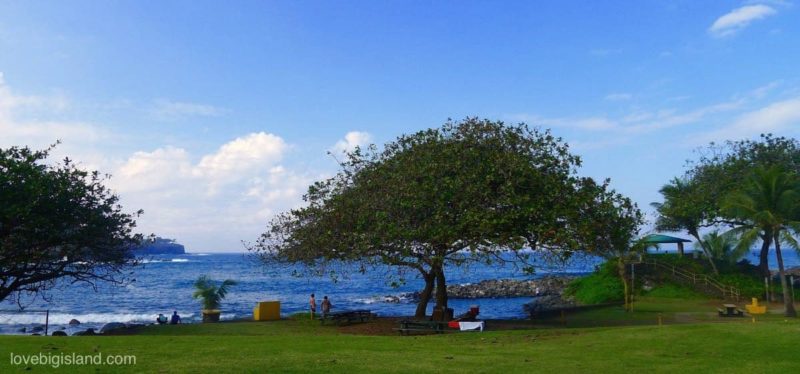
Keokea beach park is a quiet beach park with a shower and picnic tables close to Hawi and Pololu Valley. This is a good spot for a picnic and a shower after hiking down into Pololu valley
Whale watching (December – March)
The leeward side of the Kohala volcano is one of the best places on the Big Island to see whales from the shore. If you are going to Pololu Valley during whale season (between ~December and March) and want to include a whale-watching picnic to your visit you should start by checking out our DIY whale watching tips.
